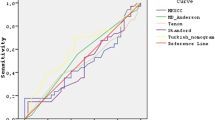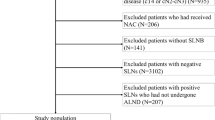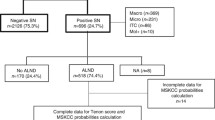Abstract
Background
Completion axillary lymph node dissection (cALND), performed after a positive sentinel lymph node biopsy (SLNB) in breast cancer patients, often results in no additional positive nodes. Scoring systems have been published to aid in the prediction of nonsentinel node metastasis. Our purpose was to assess the validity of these scoring systems in our patient population.
Methods
For 39 consecutive patients who underwent cALND after a positive SLNB, scores were calculated using retrospective patient data for each of the three scoring systems used. Receiver operating characteristics (ROC) curves were drawn, and the areas under the curves were calculated to assess the discriminative power of each system. Univariate analysis was performed to assess the predictability of individual patient and tumor characteristics.
Results
Nonsentinel nodes were positive in 23 (59%) patients. The areas under the ROC curves were 0.63, 0.70, and 0.68, respectively. The proportion of sentinel nodes that were positive and the total number of sentinel nodes retrieved were the only individual predictors of nonsentinel node metastasis.
Conclusions
Given the high incidence of retrieving no additional metastasis on cALND, individualized patient management according to risk is desirable. Scoring systems provide additional information regarding the likelihood of metastasis in nonsentinel nodes, but their predictability remains less than optimal. The use of scoring systems must be applied with caution until future studies provide a more accurate assessment of risk for patients with a positive SLNB.



Similar content being viewed by others
References
Guiliano AE, Jones RC, Brennan M, et al. Sentinel lymphadenectomy in breast cancer. J Clin Oncol 1997; 15:2345–2350
Veronesi U, Paganelli G, Galimberti V, et al. Sentinel node biopsy to avoid axillary dissection in breast cancer with clinically negative lymph nodes. Lancet 1997; 349:1864–1867
Krag D, Weaver D, Ashikaga T, et al. The sentinel node in breast cancer: a multicenter validation study. N Engl J Med 1998; 339:941–946
Veronesi U, Paganelli G, Viale G, et al. A randomized comparison of sentinel node biopsy with routine axillary dissection in breast cancer. N Engl J Med 2003; 349:546–553
Giuliano AE, Haigh PI, Brennan MB, et al. Prospective observational study of sentinel lymphadenectomy without further axillary dissection in patients with sentinel node negative breast cancer. J Clin Oncol 2000; 18:2553–2559
Hwang RF, Krishnamurthy S, Hunt KK, et al. Clinicopathologic factors predicting involvement of nonsentinel axillary nodes in women with breast cancer. Ann Surg Oncol 2003; 10:248–254
Barranger E, Coutant C, Flahault A, et al. An axilla scoring system to predict non-sentinel lymph node status in breast cancer patients with sentinel lymph node involvement. Breast Cancer Res Treat 2005; 91:113–119
Chu Ku, Turner RR, Hansen NM, et al. Do all patients with sentinel node metastsis from breast carcinoma need complete axillary node dissection? Ann Surg 1999; 229:536–541
Turner RR, Chu KU, Qi K, et al. Pathologic features associated with nonsentinel lymph node metastases in patients with metastatic breast carcinoma in a sentinel lymph node. Cancer 2000; 89:574–581
Joslyn SA, Konety BR. Effect of axillary lymphadenectomy on breast carcinoma survival. Breast Cancer Res Treat 2005; 91:11–18
Orr RK. The impact of prophylactic axillary node dissection on breast cancer survival: a Bayesian meta-analysis. Ann Surg Oncol 1999; 6:109–116
Carter CL, Allen C, Henson DC, et al. Relation of tumor size, lymph node status and survival in 24740 breast cancer cases. Cancer 1989; 63:181–187
Kakuda JT, Stuntz M, Trivedi V, et al. Objective assessment of axillary morbidity in breast cancer treatment. Am Surg 1999; 65:995–998
Purushotham AD, Upponi S, Klevesath MB, et al. Morbidity after sentinel lymph node biopsy in primary breast cancer: results from a randomized controlled trial. J Clin Oncol 2005; 23:4312–4321
Farshid G, Pradhan M, Kollias J, Gill PG. A decision aid for predicting non-sentinel node involvement in women with breast cancer and at least one positive sentinel node. The Breast 2004; 13;494–501
Tan YY, Fan YG, Lu Y, et al. Ratio of positive to total number of sentinel nodes predicts nonsentinel node status in breast cancer patients. Breast J 2005; 11:248–253
Turner RR, Chu KU, Qi K, et al. Pathologic features associated with nonsentinel lymph node metastases in patients with metastatic breast carcinoma in a sentinel lymph node. Cancer 2000; 89:574–581
Wong SL, Edwards MJ, Chao C, et al. Predicting the status of the nonsentinel axillary nodes. Arch Surg 2001; 136:563–568
Guenther JM, Hansen NM, DeFronzo LA, et al. Axillary dissection is not required for all patients with breast cancer and positive nodes. Arch Surg 2003; 138:52–56
Schrenk P, Konstantiniuk P, Wolfl S, et al. Prediction of non-sentinel lymph node status in breast cancer with a micrometastatic sentinel node. Br J Surg 2005; 92:707–713
Van Zee K, Manasseh DME, Becilacqua JLB, et al. A nomogram for predicting the likelihood of additional nodal metastases in breast cancer patients with a positive sentinel node biopsy. Ann Surg Oncol 2003; 10:1140–1151
Vargas HI, Tolmos J, Agbunag RV, et al. A validation trial of subdermal injection compared with intraparenchymal injection for sentinel lymph node biopsy in breast cancer. Am Surg 2002; 68:87–91
Cady, Blake. A contemporary view of axillary dissection. Ann Surg 2000; 232:8–9
Fant JS, Grant MD, Knox SM, et al. Preliminary outcome analysis in patients with breast cancer and a positive sentinel lymph node who declined axillary dissection. Ann Surg Oncol 2003; 10:126–130
International Breast Cancer Study Group. Randomized trial comparing axillary clearance versus no axillary clearance in older patients with breast cancer: first results of international breast cancer study group trial 10-93. J Clin Oncol 2006; 24:337–344
Fisher B, Montague E, Redmond C, et al. Findings of NSABP Protocol No. B-04 – comparison of radical mastectomy with alternative treatments for primary breast cancer. Cancer 1980; 46:1–13
Louis-Silvester C, Clough K, Asselain B, et al. Axillary treatment in conservative management of operable breast cancer: dissection or radiotherapy? Results of a randomized study with 15 years of follow-up. J Clin Oncol 2004; 22:97–101
Specht MC, Kattan MW, Gonen M, et al. Predicting nonsentinel node status after positive sentinel lymph biopsy for breast cancer: clinicians versus nomogram. Ann Surg Oncol 2005; 12:654–659
Smidt ML, Kuster DM, Jan van der Wilt G, et al. Can the Memorial Sloan-Kettering Cancer Center Nomogram predict the likelihood of nonsentinel node metastases in breast cancer patients in the Netherlands? Ann Surg Oncol 2005; 12:1066–1072
Acknowledgements
The authors would like to thank Melissa Burla, MSN, NP and Katherine Gonzalez, RN for their contributions to this work.
Author information
Authors and Affiliations
Corresponding author
Rights and permissions
About this article
Cite this article
Dauphine, C.E., Haukoos, J.S., Vargas, M.P. et al. Evaluation of Three Scoring Systems Predicting Non Sentinel Node Metastasis in Breast Cancer Patients with a Positive Sentinel Node Biopsy. Ann Surg Oncol 14, 1014–1019 (2007). https://doi.org/10.1245/s10434-006-9223-5
Received:
Revised:
Accepted:
Published:
Issue Date:
DOI: https://doi.org/10.1245/s10434-006-9223-5




